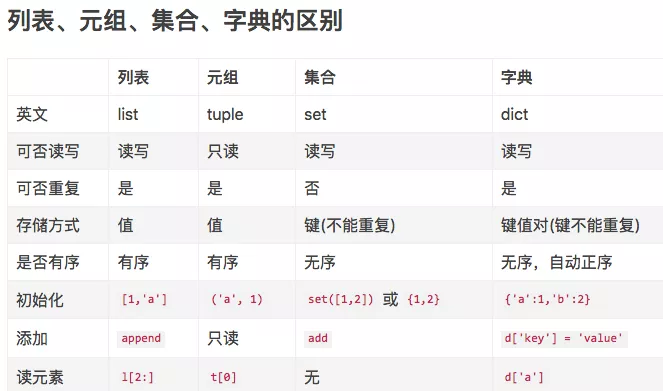python 列表,元组,字典,集合,字符串相互转换
3 年前

本文主要介绍列表,元组,字典,集合以及和字符串之间的相互转换。
1. 列表与元组的互换
# 将列表转化为元组
li = [1, 2, 3]
t = tuple(li)
print(t, type(t))
# 打印结果:(1, 2, 3) <class 'tuple'>
# 将元组转换成列表
tu = (1, 2, 3)
li = list(tu)
print(li, type(li))
# 打印结果:[1, 2, 3] <class 'list'>2. 列表与字符串的互换
# 列表转换成字符串
li = ['人', '生', '苦', '短']
str1 = ''.join(li)
print(str1, type(str1))
# 输出结果:人生苦短 <class 'str'>
# 字符串转换成列表
str2 = 'hello python'
li1 = str2.split(' ')
print(li1, type(li1))
# 输出结果:['hello', 'python'] <class 'list'>3. 列表与字典转换
# 列表转字典方式一
list1 = ['name', 'age', 'sex']
list2 = ['张三', 18, '男']
dict = {}
for i in range(len(list1)):
dict[list1[i]] = list2[i]
print(dict, type(dict))
# 输出结果:{'name': '张三', 'age': 18, 'sex': '男'} <class 'dict'>
# 列表转字典方式二:使用内置函数zip
list1 = ['name', 'age', 'sex']
list2 = ['张三', 18, '男']
d = dict(zip(list1, list2))
print(d)
# 字典转换成列表
dict = {'name': '张三', 'age': 18, 'sex': '男'}
keys = list(dict.keys())
values = list(dict.values())
print(keys, type(keys))
print(values, type(values))4.嵌套列表转字典
list3 = [['key1','value1'],['key2','value2'],['key3','value3']]
print(dict(list3))5. 列表与集合转换
# 列表转集合
list1 = [1, 3, 4, 3, 2, 1]
s1 = set(list1)
print(s1, type(s1))
# 输出结果:{1, 2, 3, 4} <class 'set'>
# 集合转列表
list2 = list(s1.intersection(s1))
print(list2, type(list2))
# 输出结果:[1, 2, 3, 4] <class 'list'>6. 元组和字符串转换
# 元组转换成字符串和列表方法一样
# 字符串转换成元组,需要将字符串转换成列表,在利用列表转成元组
list = []
a = '人生苦短'
list.append(a)
print(list)
b = tuple(list)
print(b, type(b))
# 输出结果:('人生苦短',) <class 'tuple'>7.元组和字典转换
# 字典转元组
dict = {'name': 'xiaoming', 'age': 18}
tup = tuple(dict)
print(tup) # 只转换了key
tup2 = tuple(dict.values())
print(tup2)
# 元组不能转成字典8.字典和字符串转换
# 字典转换为字符串
dic1 = {'a': 1, 'b': 2}
str1 = str(dic1)
# 输出结果:{'a': 1, 'b': 2} <class 'str'>
# 字符串转字典
dic2 = eval("{'name':'xiaoming', 'age':18}")
print(dic2, type(dic2))9.字符串和集合转换
# 字符串转集合
